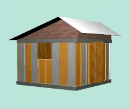All articles
Ferrocement panels gain acceptance
A new UN habitat publication highlights the Cuban experience of building with ferrocement panels, while a series of apartment houses are under construction with this technology in the Dominican Republic, as well as two community buildings in Haiti.
The "International Ferrocement Society » (IFS) organizes its 10th International Symposium on "Ferrocement and Thin Reinforced Cement Composites" (www.ferro10.com) in Havana, Cuba, in the month of October.
Pedro Galiano, a senior Cuban Architect proudly presents the first of a series of two-storey houses in the Dominican town of San Francisco de Macoris. Galiano is a pioneer of this construction technology and former president of the Cuban Union of Architects and Engineers (Union de Arquitectos e Ingenieros de Cuba, UNAIC), and since his retirement he has been consulting the Municipality of San Francisco. Among his many projects is the installation of a production facility for ferrocement panels and the construction of some buildings. Now he has started a small colony of social housing with a local developper. At the same time he is also a consultant to the programs of Sofonias Haiti* and he will supervise the installation of the second level panels in the community centers built for UNDP.
The Haitian partner of the EcoSur Network has been building shelters with the panels since the earthquake and with support from UNDP they are starting the construction of two community centers in destroyed areas in Port au Prince. This type of construction can be locally prefabricated and then assembled within a very short time, a great advantage when rebuilding in densily populated areas. The project is teaching a group of 30 people, mostly women, to produce and build with this technology.
From October 12th to 17th, the Cuban branch of the International Ferrocement Association, headed by Dr. Hugo Wainshtok, organizes its 10th World Summit in the Palacio de Convenciones in Havana where interesting presentations are schduled. There will be much debate about the use of different fibres and meshes, to modernize the old technology towards more sophisticated industrial processes, but also reports on more humble and simple applications like the three presented here.



